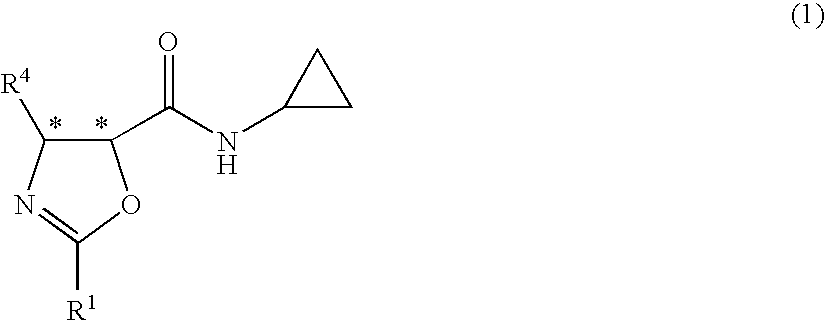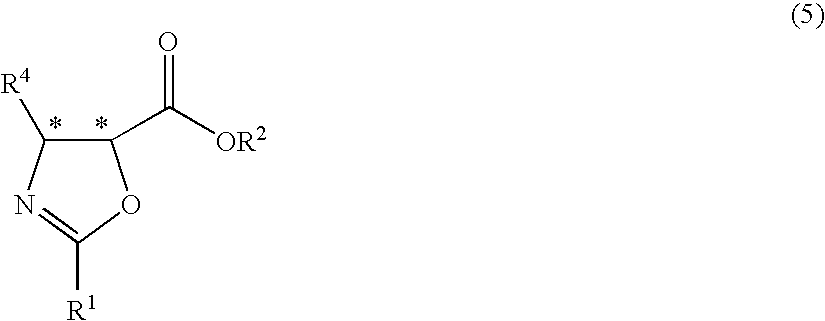Process for production of optically active-3-amino-2-hydroxypropionic cyclopropylamide derivatives and salts thereof
a technology of cyclopropylamide and 3amino-2-hydroxypropionic cyclopropylamide, which is applied in the direction of fermentation, chemistry apparatus and processes, organic chemistry, etc., can solve the problems of difficult industrialization, uneconomical, and method (1) cannot be said to be realistic, and achieves easy-to-produce effects. low cost and easy-to-produce starting points
- Summary
- Abstract
- Description
- Claims
- Application Information
AI Technical Summary
Benefits of technology
Problems solved by technology
Method used
Image
Examples
example 1
Production of ethyl (2S,3R)-3-propyl-2-oxiranecarboxylate
[0324]
[0325]Ethyl (2R,3R)-2-chloro-3-hydroxyhexanoate (1.0 g, 5 mmol), ethanol (10 ml) and potassium carbonate (2.1 g, 15 mmol) were mixed, and the mixture was stirred at 15° C. for 14 hours. Methyl tert-butyl ether (20 ml) was added. The mixture was washed with water (10 ml) three times. The organic layer was concentrated under reduced pressure to obtain the title compound (0.83 g, yield: 100%).
[0326]1H NMR (400 MHz, CDCl3): δ 4.24-4.21 (m, 2H), 3.20 (d, 1H), 3.08-3.04 (dt, 1H), 1.72-1.62 (m, 2H), 1.61-1.50 (m, 2H), 1.28 (t, 3H), 0.98 (t, 3H)
example 2
Production of methyl (2S,3R)-3-propyl-2-oxiranecarboxylate
[0327]
[0328]Methyl (2R,3R)-2-chloro-3-hydroxyhexanoate (0.9 g, 5 mmol), ethanol (10 ml) and potassium carbonate (2.1 g, 15 mmol) were mixed, and the mixture was stirred at 15° C. for 14 hours. Methyl tert-butyl ether (20 ml) was added. The mixture was washed with water (10 ml) three times. The organic layer was concentrated under reduced pressure to obtain the title compound (0.75 g, yield: 100%).
[0329]1H NMR (400 MHz, CDCl3): δ 3.81 (s, 3H), 3.23 (d, 1H), 3.18-3.15 (dt, 1H), 1.66-1.50 (m, 4H), 0.99 (t, 3H)
example 3
Production of (2S,3R)-3-propyl-2-oxiranecarboxylic acid
[0330]
[0331]Ethyl (2R,3R)-2-chloro-3-hydroxyhexanoate (5.0 g, 22 mmol) and ethanol (15 ml) were mixed, and the mixture was cooled to 5° C. To the mixture, 20% sodium ethoxide / ethanol solution (8.3 g, 24 mmol) was gradually added. The mixture was stirred at room temperature for 1 hour. The precipitated inorganic salt was separated by filtration. Potassium hydroxide (1.24 g, 24 mmol) was added to the filtrate, and the mixture was stirred at room temperature for 14 hours. The solvent was evaporated away under reduced pressure, and water (15 ml) was added. The pH was adjusted to 1.8 with concentrated hydrochloric acid. The mixture was extracted with ethyl acetate (20 ml). The solvent was evaporated away under reduced pressure to obtain the title compound (2.33 g, yield: 65%).
[0332]1H NMR (400 MHz, CDCl3): δ 3.23 (d, 1H), 3.17 (dt, 1H), 1.72-1.51 (m, 4H), 0.98 (t, 3H)
PUM
| Property | Measurement | Unit |
|---|---|---|
| temperature | aaaaa | aaaaa |
| temperature | aaaaa | aaaaa |
| temperature | aaaaa | aaaaa |
Abstract
Description
Claims
Application Information
 Login to View More
Login to View More - R&D
- Intellectual Property
- Life Sciences
- Materials
- Tech Scout
- Unparalleled Data Quality
- Higher Quality Content
- 60% Fewer Hallucinations
Browse by: Latest US Patents, China's latest patents, Technical Efficacy Thesaurus, Application Domain, Technology Topic, Popular Technical Reports.
© 2025 PatSnap. All rights reserved.Legal|Privacy policy|Modern Slavery Act Transparency Statement|Sitemap|About US| Contact US: help@patsnap.com



